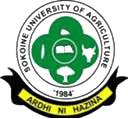Background:
In recent years, the pig industry in Tanzania has faced frequent occurrence of outbreaks of African swine fever (ASF). However, there is inadequate information on the pig value chain operation in relation to occurrence of ASF. This study aimed at mapping pig value chain and assess its contribution to the occurrence and spread of ASF in Tanzania.
Methods:
A cross sectional study was carried out in Songwe, Momba, Songea and Mbinga districts of Tanzania. Study districts were purposively selected based on the density of pig population, differences in production systems and history of ASF outbreaks. A total number of 484 pig producers and 28 traders were involved in the study. Random sampling was used to select pig producers. Pig traders were selected using snowball technique. Structured questionnaires were used to collect data on pig management and production practices, veterinary seivices, pig marketing practices and biosecurity measures using Open Data Kit (ODK) software. Semi structured interviews were conducted with key informants on perceived risk practices that are related to ASF outbreaks, challenges and recommendations on ASF prevention and control measures. Observation method was used to assess structure, facilities and practices within the pig production chain.
Results:
The main actors in the pig production chain were pig producers, assemblers, wholesalers and retailers. Unknown stock source (30%), poor husbandry practice such as free ranging (5%), poor management of waste products (73%) and poor handling of feed (73%) were risk practices in the production node. Transportation nodes operated under high risk due to frequent movements and pick-ups of ≥ 30 pigs per trip.
Conclusion:
The results demonstrated that different actors operate in the pig production, distribution and marketing chain. Each node operated under low biosecurity measures, and poor infrastructures that are likely to contribute to occurrence of ASF. There is need to improve good husbandry practices, marketing and infrastructures to increase production while ensuring pork safety.
Read More






